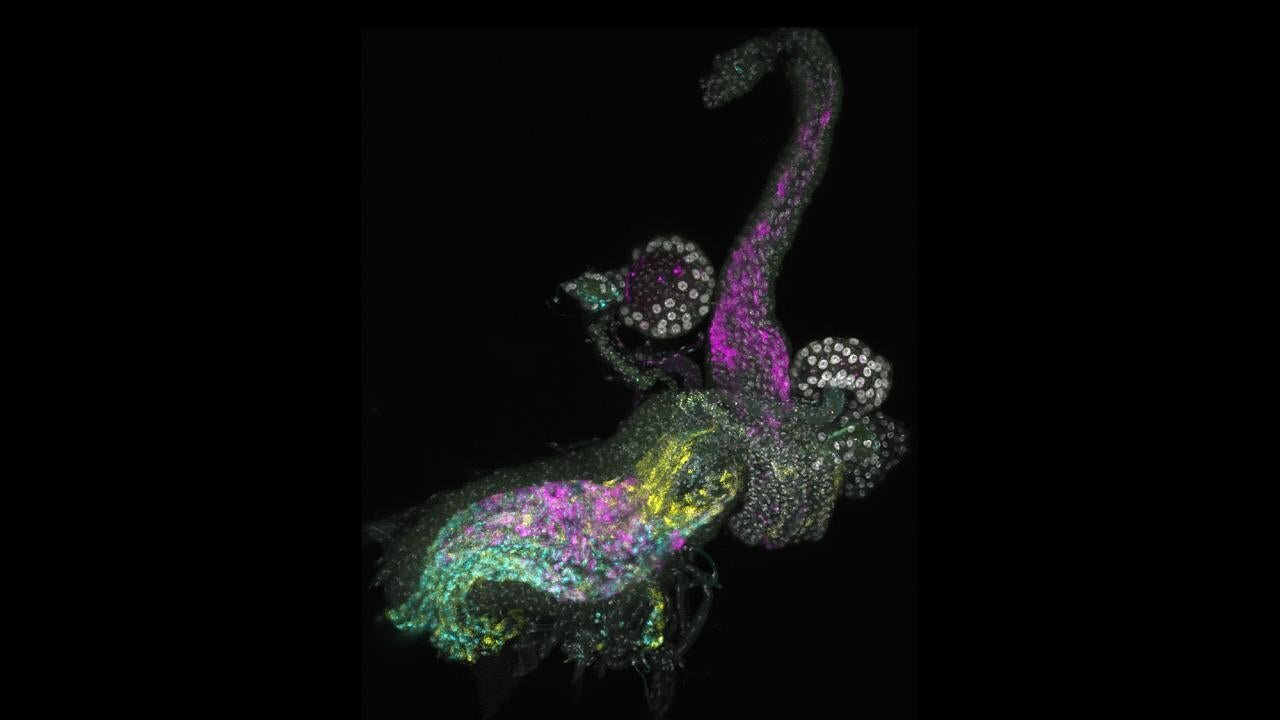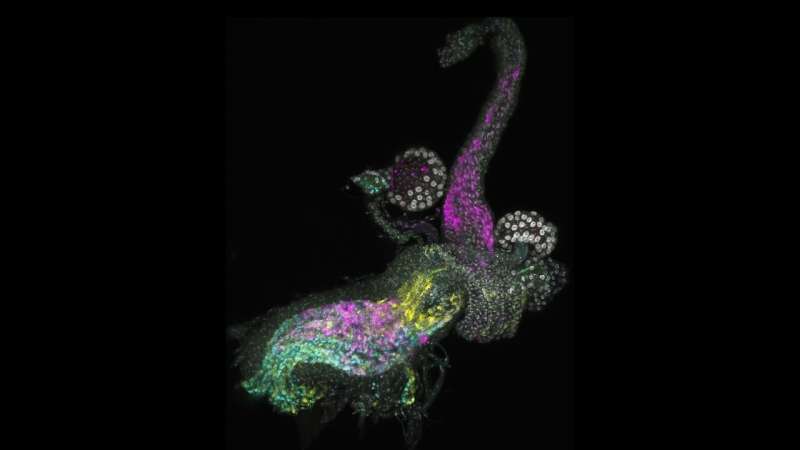

You have likely not spent much time thinking about the uterus of the fruit fly, Drosophila melanogaster. But then, neither have most scientists, even though Drosophila is one of the most thoroughly studied lab animals. Now a team of biologists at the University of California, Davis, has taken the first deep look at the Drosophila uterus and found some surprises, which could have implications not just for understanding insect reproduction and potentially, pest control, but also for understanding fertility in humans.
The work is published Oct. 25 in Proceedings of the National Academy of Sciences.
Drosophila have been a favorite subject for geneticists and developmental biologists for over a century.
“Drosophila is such a productive system in many ways,” said Rachel Thayer, a postdoctoral researcher working with Distinguished Professor David Begun at the UC Davis Department of Evolution and Ecology. There are extensive catalogs of cell types and genes for most of the fly’s organ systems. But the female reproductive organs—the uterus, female glands and sperm storage organs—have been mostly left out.
Both humans and insects have internal fertilization, so the female reproductive tract has to deal with foreign material from sperm to sexually transmitted viruses. Insects, like many other female animals including birds and reptiles, have organs that can store viable sperm for long periods.
“We wanted to identify all the cell types and their patterns of gene use for these important organs,” Thayer said.
Thayer and Begun, with co-authors Elizabeth Polston and Jixiang Xu, dissected the reproductive tracts of about 150 flies. They were able to separate cell nuclei into individual droplets and label the RNA from each cell with a sort of barcode. By sequencing the RNA, they were able to identify a profile of gene expression from individual cells and sort them into types.
“We can identify the cell types that express certain genes, and where they come from,” Thayer said.
Previously, there were no cell types from the fly uterus identified with genetic markers. The new study reveals more than 20 different cell types in the uterus and associated organs.
“The most exciting thing to me is to find cell types we had not previously predicted would exist,” Thayer said. “This is previously invisible anatomy.”
Supporting sperm storage
The study found that about 40% of genes for “seminal fluid proteins,” previously identified as being made only in male flies, are also expressed in the female fly, especially in sperm storage organs. They may be key to supporting viable sperm for long periods.
Some seminal fluid proteins are thought to manipulate the female fly in ways that benefit the male, such as by delaying the female from mating again. Such sexual conflicts have been the target of considerable, mostly theoretical, study.
“There is dispute about how big a role these sexual conflicts really play, because sexual reproduction still must be collaborative,” Thayer said. The discovery that many of these proteins are made by both male and female flies means that scientists will have to adjust their thinking about these ideas, Thayer said.
“It does not rule out the possibility of molecular sexual conflict altogether, but it does limit how this could occur,” she said.
While reproduction is, obviously, very different in humans and insects, the fruit fly can be a model for understanding animal reproduction at a fundamental level. For example, the seminal fluid proteins could lead to new ways to culture and store human sperm without freezing, which would benefit fertility treatments.
The most numerous species on Earth, insects pollinate and provide other benefits, as well as destroy crops and carry disease. Better understanding insect reproduction could lead to new control strategies.
Thayer is currently working with isolates of Drosophila from around the world to better understand how the flies are evolving in response to environmental stresses, such as climate change and pesticides.
More information:
Rachel C. Thayer et al, Regional specialization, polyploidy, and seminal fluid transcripts in the Drosophila female reproductive tract, Proceedings of the National Academy of Sciences (2024). DOI: 10.1073/pnas.2409850121
Citation:
Invisible anatomy in the fruit fly uterus: New discoveries could have implications for fertility and pest control (2024, October 25)
retrieved 25 October 2024
from https://phys.org/news/2024-10-invisible-anatomy-fruit-fly-uterus.html
This document is subject to copyright. Apart from any fair dealing for the purpose of private study or research, no
part may be reproduced without the written permission. The content is provided for information purposes only.